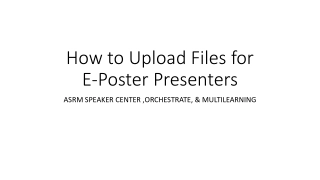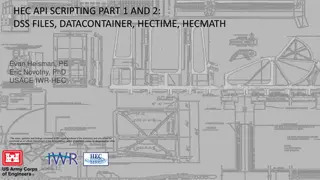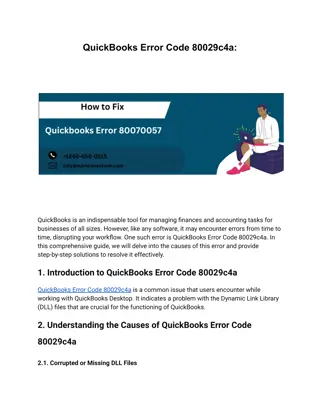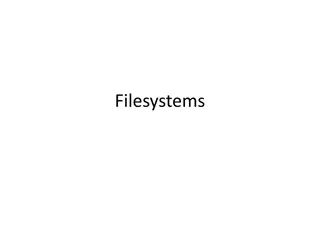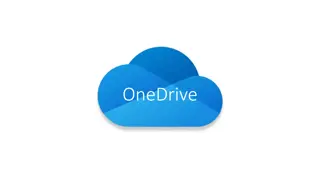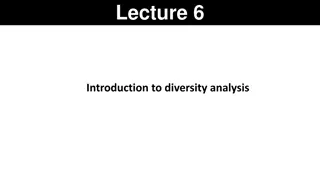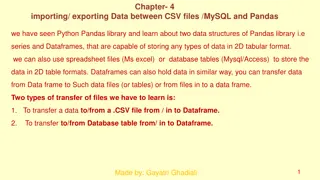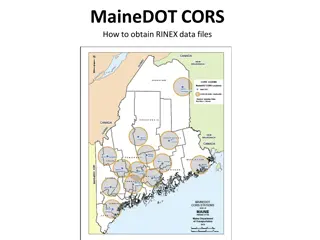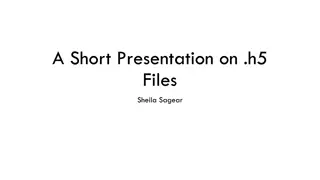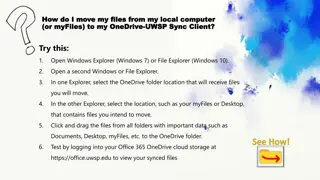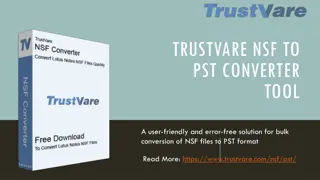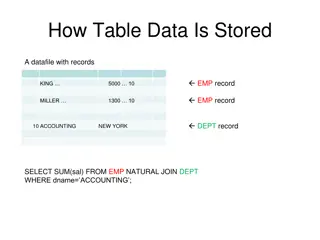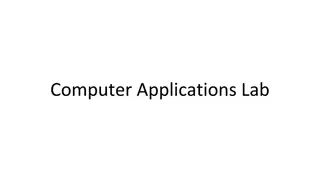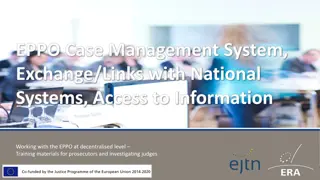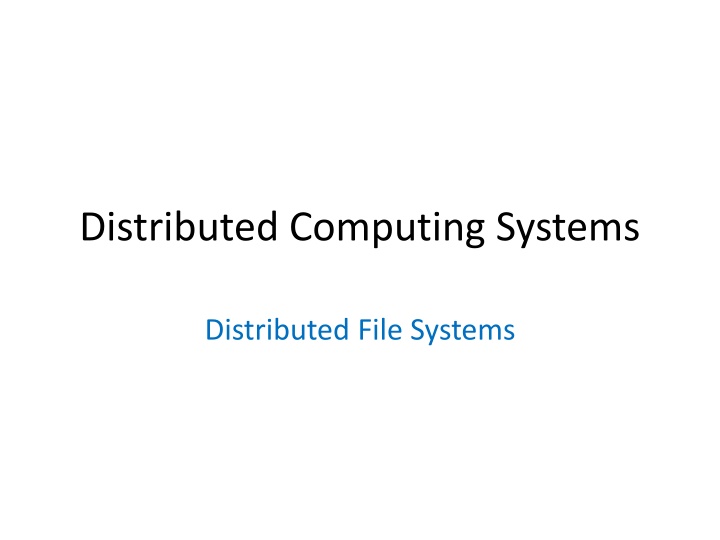
Distributed File Systems and Their Key Concepts
Explore the world of distributed file systems, including transparency, concurrent updates, replication, fault tolerance, and more. Learn about the important principles and models like NFS and AFS, and grasp the significance of scalability and performance transparency in distributed computing systems.
Download Presentation

Please find below an Image/Link to download the presentation.
The content on the website is provided AS IS for your information and personal use only. It may not be sold, licensed, or shared on other websites without obtaining consent from the author. If you encounter any issues during the download, it is possible that the publisher has removed the file from their server.
You are allowed to download the files provided on this website for personal or commercial use, subject to the condition that they are used lawfully. All files are the property of their respective owners.
The content on the website is provided AS IS for your information and personal use only. It may not be sold, licensed, or shared on other websites without obtaining consent from the author.
E N D
Presentation Transcript
Distributed Computing Systems Distributed File Systems
Distributed File Systems Early networking and files Had FTP to transfer files Telnet to remote login to other systems with files But want more transparency! local computing with remote file system Distributed file systems One of earliest distributed system components Enables programs to access remote files as if local Transparency Allows sharing of data and programs Performance and reliability comparable to local disk
Outline Overview Basic principles Concepts Models Network File System (NFS) Andrew File System (AFS) Dropbox (done) (next)
Concepts of Distributed File System Transparency Concurrent Updates Replication Fault Tolerance Consistency Platform Independence Security Efficiency
Transparency Illusion that all files are similar. Includes: Access transparency a single set of operations. Clients that work on local files can work with remote files. Location transparency clients see a uniform name space. Relocate without changing path names. Mobility transparency files can be moved without modifying programs or changing system tables Performance transparency within limits, local and remote file access meet performance standards Scaling transparency increased loads do not degrade performance significantly. Capacity can be expanded. 5
Concurrent Updates Changes to file from one client should not interfere with changes from other clients Even if changes at same time Solutions often include: File or record-level locking 6
Replication File may have several copies of its data at different locations Often for performance reasons Requires update other copies when one copy is changed Simple solution Change master copy and periodically refresh the other copies More complicated solution Multiple copies can be updated independently at same time needs finer grained refresh and/or merge 7
Fault Tolerance Function when clients or servers fail Detect, report, and correct faults that occur Solutions often include: Redundant copies of data, redundant hardware, backups, transaction logs and other measures Stateless servers Idempotent operations 8
Consistency Data must always be complete, current, and correct File seen by one process looks the same for all processes accessing Consistency special concern whenever data is duplicated Solutions often include: Timestamps and ownership information 9
Platform Independence Access even though hardware and OS completely different in design, architecture and functioning, from different vendors Solutions often include: Well-defined way for clients to communicate with servers 10
Security File systems must be protected against unauthorized access, data corruption, loss and other threats Solutions include: Access control mechanisms (ownership, permissions) Encryption of commands or data to prevent sniffing 11
Efficiency Overall, want same power and generality as local file systems Early days, goal was to share expensive resource the disk Now, allow convenient access to remotely stored files 12
Outline Overview Basic principles Concepts Models Network File System (NFS) Andrew File System (AFS) Dropbox (done) (next)
File Service Models Upload/Download Model Read file: copy file from server to client Write file: copy file from client to server Good Simple Bad Wasteful what if client only needs small piece? Problematic what if client doesn t have enough space? Consistency what if others need to modify file? Remote Access Model File service provides functional interface Create, delete, read bytes, write bytes, Good Client only gets what s needed Server can manage coherent view of file system Bad Possible server and network congestion Servers used for duration of access Same data may be requested repeatedly
Semantics of File Service Sequential Semantics Read returns result of last write Easily achieved if Only one server Clients do not cache data But Performance problems if no cache Can instead write-through Must notify clients holding copies Requires extra state, generates extra traffic Session Semantics Relax sequential rules Changes to open file are initially visible only to process that modified it Last process to modify file wins Can hide or lock file under modification from other clients
Accessing Remote Files (1 of 2) For transparency, implement client as module under VFS (Additional picture next slide)
Accessing Remote Files (2 of 2) Virtual file system allows for transparency
Stateful or Stateless Design Stateful Stateless Server maintains no information on client accesses Each request must identify file and offsets Server can crash and recover No state to lose No open/close needed They only establish state No server space used for state Don t worry about supporting many clients Problems if file is deleted on server File locking not possible Server maintains client-specific state Shorter requests Better performance in processing requests Cache coherence possible Server can know who s accessing what File locking possible
Caching Hide latency to improve performance for repeated accesses Four places: Server s disk Server s buffer cache (memory) Client s buffer cache (memory) Client s disk Client caches risk cache consistency problems
Concepts of Caching (1 of 2) Centralized control Keep track of who has what open and cached on each node Stateful file system with signaling traffic Read-ahead (pre-fetch) Request chunks of data before needed Minimize wait when actually needed But what if data pre-fetched is out of date?
Concepts of Caching (2 of 2) Write-through All writes to file sent to server What if another client reads its own (out-of-date) cached copy? All accesses require checking with server Or server maintains state and sends invalidations Delayed writes (write-behind) Only send writes to files in batch mode (i.e., buffer locally) One bulk write is more efficient than lots of little writes Problem: semantics become ambiguous Watch out for consistency others won t see updates! Write on close Only allows session semantics If lock, must lock whole file
Outline Overview Basic principles Network File System (NFS) Andrew File System (AFS) Dropbox (done) (done) (next)
Network File System (NFS) Introduced in 1984 (by Sun Microsystems) Not first made, but first to be used as product Made interfaces in public domain Allowed other vendors to produce implementations Internet standard is NFS protocol (version 3) RFC 1913 Still widely deployed, up to v4 but maybe too bloated so v3 widely used
NFS Overview Provides transparent access to remote files Independent of OS (e.g., Mac, Linux, Windows) or hardware Symmetric any computer can be server and client But many institutions have dedicated server Export some or all files Must support diskless clients Recovery from failure Stateless, UDP, client retries High performance Caching and read-ahead
Underlying Transport Protocol Initially NSF ran over UDP using Sun RPC Why UDP? Slightly faster than TCP No connection to maintain (or lose) NFS is designed for Ethernet LAN Relatively reliable Error detection but no correction NFS retries requests
NSF Protocols Since clients and servers can be implemented for different platforms, need well-defined way to communicate Protocol Protocol agreed upon set of requests and responses between client and servers Once agreed upon, Apple implemented Mac NFS client can talk to a Sun implemented Solaris NFS server NFS has two main protocols Mounting Protocol: Request access to exported directory tree Directory and File Access Protocol: Access files and directories (read, write, mkdir, readdir )
NFS Mounting Protocol Request permission to access contents at pathname Client Parses pathname Contacts server for file handle Server Returns file handle: file device #, i-node #, instance # Client Create in-memory VFS i-node at mount point Internally point to r-node for remote files Client keeps state, not server Soft-mounted if client access fails, throw error to processes. But many do not handle file errors well Hard-mounted client blocks processes, retries until server up (can cause problems when NFS server down)
NFS Architecture In many cases, on same LAN, but not required Can even have client-server on same machine Directories available on server through /etc/exports When client mounts, becomes part of directory hierarchy Server 1 Client (root) Server 2 (root) (root) export . . . vmunix usr nfs Remote Remote people users students x staff mount mount big jon bob . . . jim ann jane joe File system mounted at /usr/students is sub-tree located at /export/people in Server 1, and file system mounted at /usr/staff is sub-tree located at /nfs/users in Server 2
Example NFS exports File File stored on server, typically /etc/exports # See exports(5) for a description. /public 192.168.1.0/255.255.255.0 (rw,no_root_squash) Share the folder /public Restrict to 192.168.1.0/24 Class C subnet Use * for wildcard/any Give read/write access Allow the root user to connect as root
NFS Automounter Automounter only mount when access empty NFS-specified dir Attempt unmount every 5 minutes Avoids long start up costs when many NSF mounts Useful if users don t need
NFS Access Protocol Most file operations supported from server to client (e.g., read(), write(), getattr()) First, perform lookup RPC Returns file handle and attributes (not like open() since no information stored on server) Doesn t support open() and close() Instead on, say, read(), client sends RPC handle, UFID and offset Allows server to be stateless, not remember connections Better for scaling and robustness However, typical Unix can lock file on open(), unlock on close() NFS must run separate lock daemon
NFS Access Operations NFS has 16 functions (v2, v3 added six more)
NFS Caching - Server Keep file data in memory as much as possible (avoid slow disk) Read-ahead get subsequent blocks (typically 8 KB chunk) before needed Delayed write only put data on disk when memory cache (typically every 30 seconds) Server responds by write-through (data to disk when client asks) Performance can suffer, so another option only when file closed, called commit
NFS Caching - Client Reduce number of requests to server (avoid slow network) Cache read, write, getattr, readdir Can result in different versions at client Validate with timestamp When contact server (open() or new block), invalidate block if server has newer timestamp Clients responsible for polling server Typically 3 seconds for file Typically 30 seconds for directory Send written (dirty) blocks every 30 seconds Flush on close()
Improve Read Performance Transfer data in large chunks 8K bytes default (that used to be large) Read-ahead Optimize for sequential file access Send requests to read disk blocks before requested by process
Problems with NFS File consistency (client caches) Assumes clocks are synchronized No locking Separate lock manager needed, but adds state No reference count for open files Could delete file that others have open! File permissions may change Invalidating access
NFS Version 3 TCP support UDP caused more problems on WANs (errors) All traffic can be multiplexed on one connection Minimizes connection setup Large-block transfers Negotiate for optimal transfer size No fixed limit on amount of data per request
NFS Version 4 Adds state to system Supports open() operations since can be maintained on server Read operations not absolute, but relative, and don t need all file information, just handle Shorter messages Locking integrated Includes optional security/encryption
Outline Overview Basic principles Network File System (NFS) Andrew File System (AFS) Dropbox (done) (done) (done) (next)
Andrew File System (AFS) Developed at CMU (hence the Andrew from Andrew Carnegie ) Commercialized through IBM to OpenAFS (http://openafs.org/) Transparent access to remote files Using Unix-like file operations (creat, open, ) But AFS differs markedly from NFS in design and implementation
General Observations Motivating AFS For Unix users Most files are small, less than 10 KB in size read() more common than write() - about 6x Sequential access dominates, random rare Files referenced in bursts used recently, will likely be used again Typical scenarios for most files: Many files for one user only (i.e., not shared), so no problem Shared files that are infrequently updated to others (e.g., code, large report) no problem Local cache of few hundred MB enough of a working set for most users What doesn t fit? databases updated frequently, often shared, need fine-grained control Explicitly, AFS not for databases
AFS Design Scalability is most important design goal More users than other distributed systems Key strategy is caching of whole files at clients Whole-file serving entire file and directories Whole-file caching clients store cache on disk Typically several hundred Permanent so still there if rebooted
AFS Example Process at client issues open() system call Check if local cached copy (Yes, then use. No, then next step.) Send request to server Server sends back entire copy Client opens file (normal Unix file descriptor) read(), write(), etc. all apply to copy When close(), if local cached copy changed, send back to server
AFS Questions How does AFS gain control on open()or close()? What space is allocated for cached files on workstations? How does FS ensure cached copies are up-to- date since may be updated by several clients?
AFS Architecture Workstations Servers Venus User program UNIX kernel Vice UNIX kernel Venus User program UNIX kernel Network Vice Venus User program UNIX kernel UNIX kernel Vice implements flat file system on server Venus intercepts remote requests, pass to vice
System Call Interception in AFS Kernel mod to open() and close() If remote, pass to Venus Workstation User program Venus Venus UNIX file system calls Non-local file operations UNIX kernel UNIX file system Local disk
Cache Consistency Vice issues callback promise with file If server copy changes, it calls back to Venus processes, cancelling file Note, change only happens on close of whole file If Venus process opens file, must fetch copy from server If reboot, cannot be sure callbacks are all correct (may have missed some) Checks with server for each open Note, versus traditional cache checking, AFS far less communication for non-shared, read-only files
Implementation of System Calls in AFS Net User process open(FileName, mode) UNIX kernel If FileName refers to a file in shared file space, pass the request to Venus. Venus Vice Check list of files in local cache. If not present or there is no valid callback promise, send a request for the file to the Vice server that is custodian of the volume containing the file. Transfer a copy of the file and a callback promise to the workstation. Log the callback promise. Place the copy of the file in the local file system, enter its local name in the local cache list and return the local name to UNIX. Open the local file and return the file descriptor to the application. Perform a normal UNIX read operation on the local copy. Perform a normal UNIX write operation on the local copy. read(FileDescriptor, Buffer, length) write(FileDescriptor, Buffer, length) close(FileDescriptor) Close the local copy and notify Venus that the file has been closed.If the local copy has been changed, send a copy to the Vice server that is the custodian of the file. Replace the file contents and send a callback to all other clients holding callback promises on the file.
Update Semantics No other access control mechanisms If several workstations close() file after writing, only last file will be written Others silently lost Clients must implement concurrency control separately If two processes on same machine access file, local Unix semantics apply
AFS Misc 1989: Benchmark with 18 clients, standard NFS load Up to 120% improvement over NFS 1996: Transarc (acquired by IBM) Deployed on 1000 servers over 150 sites 96-98% cache hit rate Today, some AFS cells up to 25,000 clients (Morgan Stanley) OpenAFS standard: http://www.openafs.org/

